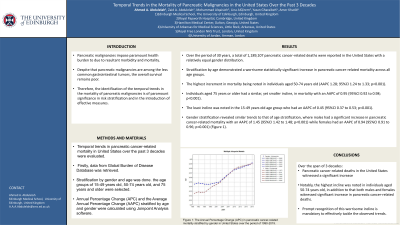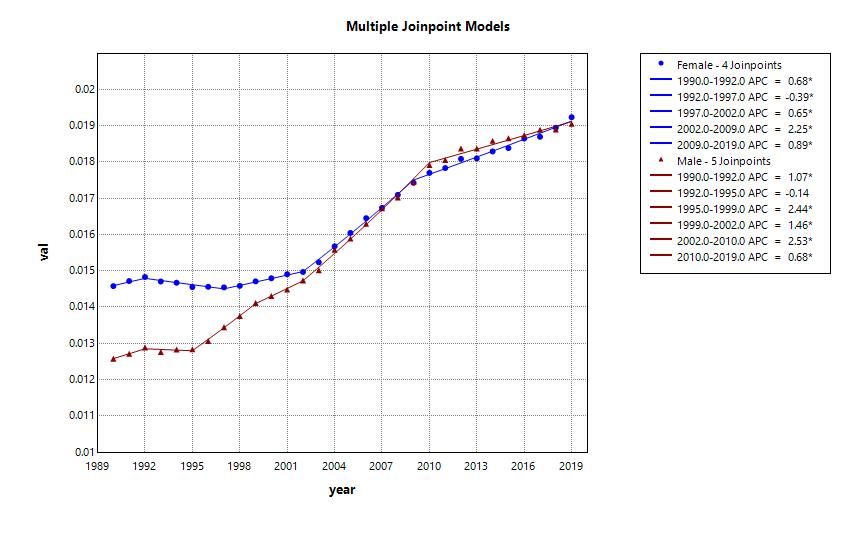Monday Poster Session
Category: Biliary/Pancreas
P1741 - Temporal Trends in the Mortality of Pancreatic Malignancies in the United States Over the Past 3 Decades
Monday, October 28, 2024
10:30 AM - 4:00 PM ET
Location: Exhibit Hall E

Has Audio

Ahmed A. A. Abdulelah, MD
University of Edinburgh
Edinburgh, Scotland, United Kingdom
Presenting Author(s)
Ahmed A. Abdulelah, MD1, Zaid A. Abdulelah, MD2, Mohammad Alqaisieh, MD3, Lina AlQirem, MD4, Yazan Gharaibeh, MD5, Amer Khatib, MD6
1University of Edinburgh, Edinburgh, Scotland, United Kingdom; 2Royal Papworth Hospital, Cambridge, England, United Kingdom; 3Hamilton Medical Center, Dalton, GA; 4University of Arkansas for Medical Sciences, Little Rock, AR; 5Royal Free London NHS Trust, London, England, United Kingdom; 6University of Jordan, Amman, 'Amman, Jordan
Introduction: Pancreatic malignancies impose paramount health burden to due to resultant morbidity and mortality. Despite that pancreatic malignancies are among the less common gastrointestinal tumors, the overall survival remains poor. Therefore, the identification of the temporal trends in the mortality of pancreatic malignancies is of paramount significance in risk stratification and in the introduction of effective measures.
Methods: Temporal trends in pancreatic cancer-related mortality in the United States over the past 3 decades were firstly evaluated by assessing the relevant data from the Global Burden of Diseases 2019 database. The Annual Percentage Change (APC) and the Average Annual Percentage Change (AAPC) were stratified by age and gender and were calculated using Joinpoint Analysis software (v 5.2.0, National Cancer Institute).
Results: Over the period of 30 years, a total of 1,189,107 pancreatic cancer-related deaths were reported in the United States with a relatively equal gender distribution. Stratification by age demonstrated a worrisome statistically significant increase in pancreatic cancer-related mortality across all age groups, with the highest increment in mortality being noted in individuals aged 50-74 years old (AAPC 1.28; 95%CI 1.24 to 1.33; p< 0.001). Individuals aged 75 years or older had a similar, yet smaller incline, in mortality with an AAPC of 0.95 (95%CI 0.92 to 0.98; p< 0.001). The least incline was noted in the 15-49 years old age group who had an AAPC of 0.45 (95%CI 0.37 to 0.53; p< 0.001). Gender stratification revealed similar trends to that of age stratification, where males had a significant increase in pancreatic cancer-related mortality with an AAPC of 1.45 (95%CI 1.42 to 1.48; p< 0.001) while females had an AAPC of 0.94 (95%CI 0.91 to 0.96; p< 0.001) (Figure 1).
Discussion: Pancreatic cancer-related deaths in the United States witnessed a significant increase over a span of 3 decades. Notably, the highest incline was noted in individuals aged 50-74 years old, in addition to that both males and females witnessed significant increase in pancreatic cancer-related deaths. Prompt recognition of this worrisome incline is mandatory to effectively tackle the observed trends.

Disclosures:
Ahmed A. Abdulelah, MD1, Zaid A. Abdulelah, MD2, Mohammad Alqaisieh, MD3, Lina AlQirem, MD4, Yazan Gharaibeh, MD5, Amer Khatib, MD6. P1741 - Temporal Trends in the Mortality of Pancreatic Malignancies in the United States Over the Past 3 Decades, ACG 2024 Annual Scientific Meeting Abstracts. Philadelphia, PA: American College of Gastroenterology.
1University of Edinburgh, Edinburgh, Scotland, United Kingdom; 2Royal Papworth Hospital, Cambridge, England, United Kingdom; 3Hamilton Medical Center, Dalton, GA; 4University of Arkansas for Medical Sciences, Little Rock, AR; 5Royal Free London NHS Trust, London, England, United Kingdom; 6University of Jordan, Amman, 'Amman, Jordan
Introduction: Pancreatic malignancies impose paramount health burden to due to resultant morbidity and mortality. Despite that pancreatic malignancies are among the less common gastrointestinal tumors, the overall survival remains poor. Therefore, the identification of the temporal trends in the mortality of pancreatic malignancies is of paramount significance in risk stratification and in the introduction of effective measures.
Methods: Temporal trends in pancreatic cancer-related mortality in the United States over the past 3 decades were firstly evaluated by assessing the relevant data from the Global Burden of Diseases 2019 database. The Annual Percentage Change (APC) and the Average Annual Percentage Change (AAPC) were stratified by age and gender and were calculated using Joinpoint Analysis software (v 5.2.0, National Cancer Institute).
Results: Over the period of 30 years, a total of 1,189,107 pancreatic cancer-related deaths were reported in the United States with a relatively equal gender distribution. Stratification by age demonstrated a worrisome statistically significant increase in pancreatic cancer-related mortality across all age groups, with the highest increment in mortality being noted in individuals aged 50-74 years old (AAPC 1.28; 95%CI 1.24 to 1.33; p< 0.001). Individuals aged 75 years or older had a similar, yet smaller incline, in mortality with an AAPC of 0.95 (95%CI 0.92 to 0.98; p< 0.001). The least incline was noted in the 15-49 years old age group who had an AAPC of 0.45 (95%CI 0.37 to 0.53; p< 0.001). Gender stratification revealed similar trends to that of age stratification, where males had a significant increase in pancreatic cancer-related mortality with an AAPC of 1.45 (95%CI 1.42 to 1.48; p< 0.001) while females had an AAPC of 0.94 (95%CI 0.91 to 0.96; p< 0.001) (Figure 1).
Discussion: Pancreatic cancer-related deaths in the United States witnessed a significant increase over a span of 3 decades. Notably, the highest incline was noted in individuals aged 50-74 years old, in addition to that both males and females witnessed significant increase in pancreatic cancer-related deaths. Prompt recognition of this worrisome incline is mandatory to effectively tackle the observed trends.

Figure: Figure 1: The Annual Percentage Change (APC) of pancreatic cancer-related deaths stratified by gender in the United States during the period of 1990-2019.
Disclosures:
Ahmed Abdulelah indicated no relevant financial relationships.
Zaid Abdulelah indicated no relevant financial relationships.
Mohammad Alqaisieh indicated no relevant financial relationships.
Lina AlQirem indicated no relevant financial relationships.
Yazan Gharaibeh indicated no relevant financial relationships.
Amer Khatib indicated no relevant financial relationships.
Ahmed A. Abdulelah, MD1, Zaid A. Abdulelah, MD2, Mohammad Alqaisieh, MD3, Lina AlQirem, MD4, Yazan Gharaibeh, MD5, Amer Khatib, MD6. P1741 - Temporal Trends in the Mortality of Pancreatic Malignancies in the United States Over the Past 3 Decades, ACG 2024 Annual Scientific Meeting Abstracts. Philadelphia, PA: American College of Gastroenterology.
